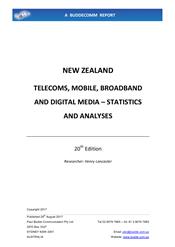2017 New Zealand - Telecoms, Mobile, Broadband and Digital Media - Statistics and Analyses

Last updated: 28 Aug 2017 Update History
Report Status: Archived
Report Pages: 108
Analyst: Henry Lancaster
Publication Overview
This report provides a comprehensive overview of trends and developments in New Zealand’s telecommunications market. The report analyses the mobile, internet, broadband, digital TV and converging media sectors. Subjects include:
- Market and industry analyses, trends and developments;
- Facts, figures and statistics;
- Industry and regulatory issues;
- Infrastructure developments;
- Major Players, Revenues, Subscribers, ARPU, MoU;
- Internet, VoIP, IPTV;
- Mobile Voice and Data Markets;
- Broadband (FttP, DSL, cable, wireless);
- Convergence and Digital Media;
- Mobile subscriber and ARPU forecasts;
- Government policies affecting the telecoms industry;
- Market liberalisation and industry issues;
- Telecoms operators – privatisation, IPOs, acquisitions, new licences;
- Mobile technologies (GSM; 3G, HSPA, LTE).
Researchers: Henry Lancaster
Current publication date:- August 2017 (20th Edition)
Executive Summary
New Zealand government approves major telecom reform package
The overall number of broadband subscribers in New Zealand has increased steadily in recent years, though at a slower pace in line with higher market penetration. The principal growth areas have been in the mobile broadband and fibre sectors. This trend will continue over the coming years as the Ultra-Fast Broadband (UFB) service sees greater uptake among consumers. By March 2017 almost three quarters of the build in UFB1 areas had been completed, with about a third of premises taking a service. The second phase of the UFB (UFB2) will extend coverage to 84% of the population by 2024. In conjunction with the UFB, the incumbent telco Spark is planning to replace its legacy PSTN network with an IP-based network by 2022.
New Zealand’s mobile market continues to undergo significant developments. There have been considerable gains made in LTE services, with effective competition between Spark, Vodafone NZ and the country’s third mobile operator 2degrees. Coverage from LTE networks has widened considerably in recent quarters, supported by the Rural Broadband Initiative rollout which is adding a large number of mobile cells to new or underserved areas. This has bolstered the uptake of mobile broadband. Network operators also provide among the fastest LTE data rates globally.
With improved broadband connectivity, the average price per GB of data for fixed-line broadband has fallen to about a fifth of that four years ago, while 10% of broadband connections are now at a tier of at least 100Mb/s.
This report assesses the key statistical data and regulatory measures in New Zealand’s telecom market. It covers the fixed-line sector and the progress of the UFB network rollout. The report also covers the fixed and wireless broadband markets, noting the rapid take-up of fibre-based services among consumers. In addition the report analyses developments in the mobile voice and data segments.
Key developments:
- Government signs off on a reform package aimed at improving the Telecommunications Act and modernising the telecom sector;
- Rebranded Crown Infrastructure Partners to invest in greenfield housing infrastructure;
- Spark, 2degrees and Vodafone make a joint bid for RBI2;
- Spark planning to replace PSTN network with an IP-based network by 2022;
- Vodafone NZ’s proposed merger with Sky cancelled;
- Vodafone NZ begins upgrade to DOCSIS3.1 technology;
- Kohlberg Kravis Roberts retracts bid for Vocus Communications;
- Commerce Commission planning a review of competition in the mobile market in 2018;
- Vodafone New Zealand and Spark commit to using LoRa technologies from 2018;
- Vodafone New Zealand reports 2.8% increase in revenue for fiscal 2017;
- Spark partners with Nokia to develop a path to 5G;
- 2degrees extends LTE to 85% of its network;
- Report update includes ComCom and Statistics New Zealand data for 2016, operator data to June 2017, recent market developments.
Companies mentioned in this report:
Spark New Zealand, Chorus, Vodafone New Zealand, 2degrees, TelstraClear, Orcon, Snap, CallPlus, CityLink, Vector, Fyx, NOW, Airnet, WorldxChange Communications, Maxnet, Vocus, Skinny, Clear Mobitel, Black+White, Compass, Gemalto.
Related Reports
- New Zealand - Telecoms, Mobile and Broadband - Statistics and Analyses
- South Pacific Islands - Telecoms, Mobile and Broadband - Statistics and Analyses
- Samoa - Telecoms, Mobile and Broadband - Statistics and Analyses
- Papua New Guinea - Telecoms, Mobile and Broadband - Statistics and Analyses
- Australia - Telecoms, Mobile and Broadband - Statistics and Analyses
- French Polynesia - Telecoms, Mobile and Broadband - Statistics and Analyses
- New Caledonia - Telecoms, Mobile and Broadband - Statistics and Analyses
- Vanuatu - Telecoms, Mobile and Broadband - Statistics and Analyses
Share this Report
TMT Intelligence
A platform to scale your intelligence tasks
Monitor critical insights with our AI-powered Market Intelligence Platform gathering and analyzing intelligence in real time. With AI trained to spot emerging trends and detect new strategic opportunities, our clients use TMT Intelligence to accelerate their growth.
If you want to know more about it, please see:
Research Methodology
BuddeComm's strategic business reports contain a combination of both primary and secondary research statistics, analyses written by our senior analysts supported by a network of experts, industry contacts and researchers from around the world as well as our own scenario forecasts.
For more details, please see:
More than 4,000 customers from 140 countries utilise BuddeComm Research
Are you interested in BuddeComm's Custom Research Service?
Hot Topics
News & Views
Have the latest telecommunications industry news delivered to your inbox by subscribing to BuddeComm's weekly newsletter.